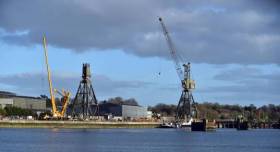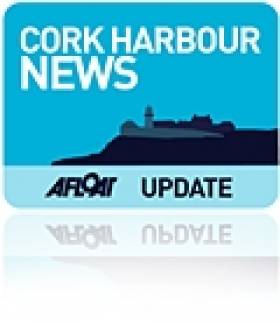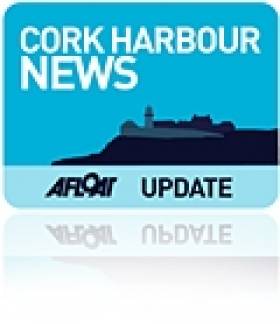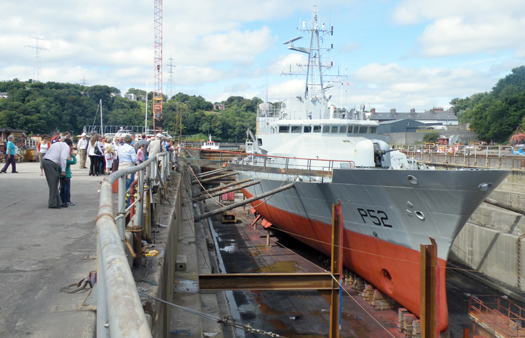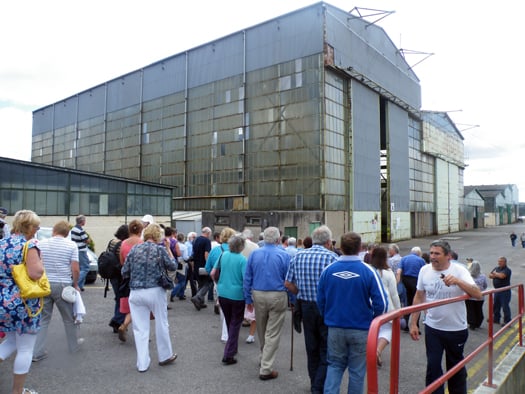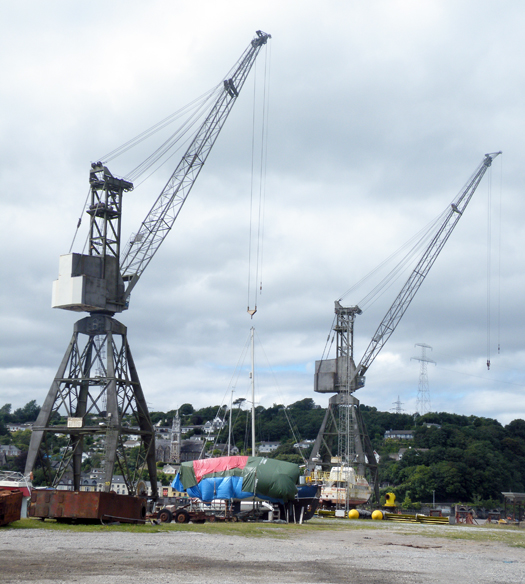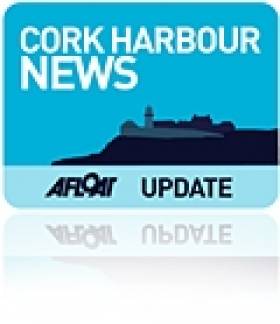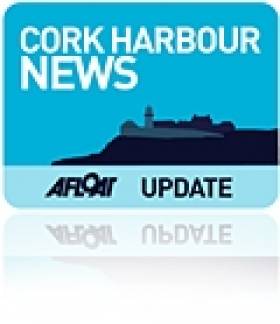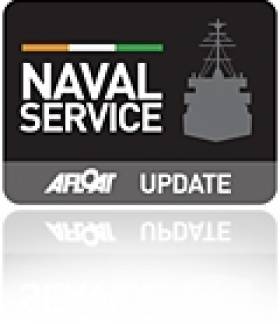Displaying items by tag: Verolme Cork Dockyard
Iconic Cranes at Verolme Cork Harbour Come Down
#CorkHarbour - A pair of historic cranes which have loomed large over Cork Harbour for six decades are being dismantled.
The cranes the Evening Echo writes, were used for building ships at the Verolme Dockyard at Rushbrooke, which closed in 1984 (see: Afloat's coverage on 160 years of Cork Shipbuilding).
They have been central to the skyline of Rushbrooke, west of Cobh and across the harbour from Monkstown for over 60 years.
Dutch company Verolme once employed more than 1,100 workers at the site and many ships were launched there including Irish Naval Vessel LÉ Eithne.
The site is now run by the Doyle Shipping Group which has confirmed that the iconic twin cranes will be dismantled fully within the next week due to concerns that they are dangerous.
To read more click the report here.
Afloat adds the site is ironically where much larger gantry cranes have recently been assembled by manufacturer Liebherr for export.
Last week the heavylift vessel HHL Lagos loaded with the cranes on board called to a UK port where the ship-to-shore cranes will be used in a container terminal.
#IrishShipping@VCD – Irish Shipping Ltd had vessels built in the UK, outside Europe and notably during the tenure of Verolme Cork Dockyard which launched larger vessels before the 1984 closure of the company, writes Jehan Ashmore.
It should be also noted when ISL was formed in 1941, this included taking on the abandoned Cork dock 'yard' that was Rushbrooke Dockyard, where such facilities date to 1853. The yard allowed their ships to be repaired at the newly created Cork Dockyard Ltd.
The yard would change hands in 1959 as ISL invited Dutch shipping magnet Cornelius Verolme to purchase the dockyard and develop the Irish shipbuilding industry. Under the leadership of Verolme, 33 vessels were launched for various owners from the yard that at its peak employed 1,500 workers. For 25 years shipbuilding and offshore installations took place at the yard until its closure in 1984.
More than a decade later, the yard site was purchased in 1995 by the Burke Group. The 44-acre facility was reopened under the same name of Cork Dockyard Ltd running as a ship-repairer, engineering and fabrication business.
In the year before ISL's collapse, V.C.D. built the 'Panamax' bulk-carrier Irish Spruce. At almost 72,000dwt /40,000grt, she was easily the largest ever ISL ship built. In 1983 she was launched down the slipway at Rushbrooke onto the River Lee.
According to 'Irish Shipping Ltd- A Fleet History' (published in 2013) the chapter on the bulker gives the following principle dimensions: length 226m, breath 32.5m and a draught of 14.3m. She had 7 self-cleating McGregor holds. Her superstructure of bridge, accommodation and facilities was designed to a very high standard.
The order to have Irish Spruce built in Ireland was placed by a subsidiary of ISL, which itself was a state-owned company. The decision by the Irish Government at the time was controversial given the option of a far cheaper alternative from a Japanese yard. The decision proved costly, as the shipping company was already under financial burden.
Despite management and politics, Irish Spruce from a maritime perspective presented an impressive example of Irish shipbuilding skills, however she had the indignity of been laid-up under arrest in Marseilles when the company got into troubled waters.
The final ship from V.C.D. was the HPV L.E. Eithne (P31) ordered by the Department of Defence for the Naval Service and launched in 1984. The helicopter carrying HPV represented the last large ship completed in a major yard within the republic.
Last year during the national 'Gathering', events as previously reported commemorated Cork's shipbuilding heritage and workers. Centre-stage to this era of ship construction was the former shipyard of V.C.D.
#VerolmeWeekend – To mark the finale of Cork Dockyard Workers Gathering Weekend, the last Mayor of Cobh Town Council, John Mulvihill Jnr, attended yesterday a plaque unveiling dedicated to shipyard workers to include Verolme Cork Dockyard in Rushbrooke, writes Jehan Ashmore.
Among the large crowd of former VCD employees, family and friends, was John Brennan who was master of ceremonies at Cork Dockyard, (formely VCD) which is a ship-repair only facility that is part of the Doyle Shipping Group.
Conor Doyle of the Doyle Group spoke of the wonderful history of shipbuilding in Cork Harbour and he said the group remained committed to the dockyard which has the 'potential' for further development should the demands from the offshore energy industry require.
During the proceedings, poetry and song celebrated the lives and workers of shipbuilding yards throughout Cork Harbour in a history that stretches beyond VCD's formation in 1959 but back to 1860.
An anchor was restored recently for the memorial occasion and where a bottle of champagne was smashed against it by Delia Webster of Cobh Tourism.
The Port of Cork, Cork Dockyard, Cobh Tourism and Irish Rail organised the commemorative weekend which involved a shipping lecture programme held in the Commodore Hotel, tours of L.E. Aoife alongside Cobh's waterfront. A mass in St. Colman's Cathedral was held and where a baptismal font was restored by former VCD staff.
Also part of the weekend was a photographic exhibition of ships built at VCD which remains open to the public in the Cobh Heritage Centre until 15 September.
The commemorative plaque was unveiled by Henk Ven der Puil, son of the late Gerard Van Der Puil, Managing Director of VCD. Father Michael Leamey performed a blessing of the plaque..
At its prime VCD employed more than 1,200 people working in ship-building, ship-repair, offshore platform modules and many other engineering enterprises.
During its quarter century existence, VCD built a total of 33 vessels, mostly for Irish concerns, among them Irish Shipping Ltd (ISL), B+I Line (including the last 'Leinster' as previously posted), Arklow Shipping and overseas clients and notably the bulker Irena Dan.
Naval ship LE Niamh in dry dock. Photo: Jehan Ashmore
The first vessel built was Irish Rowan, other ships built for ISL included the 75,000dwt Irish Spruce, a 'Panamax' bulker completed in the early 1970s.
L.E. Eithne (P31) was commissioned as the last vessel out of five built for the Naval Service and indeed she is also the last ever ship to be launched from the Rushbrooke shipyard in 1984.
Following the plaque unveiling, nostalgic tours of the dockyard took place which included access to the large series of building halls, the ship launch slipways and dry-dock / graving dock, where the Naval Service OPV L.E. Niamh (P52) was undergoing an overhaul.
The building halls. Photo: Jehan Ashmore
The remaining cranes. Photo: Jehan Ashmore
#corkharbour – A Cork Harbour photographic exhibition of close to 200 photographs covering all aspects of the development of Cork Dockyard, the ships built and repaired, and the people working there, will be staged at Cobh Heritage Centre until the 15th September.
For over 150 years Cork Harbour and the River Lee has long been associated with both shipping and shipbuilding, with the relationship between Cork Dockyard and Irish Shipping Limited (ISL) dating back to 1941, when a wholly owned subsidiary of ISL was set up by the Dept. of Industry and Commerce (Cork Dockyard Limited) to take over the operation of the dockyard.
In 1946, the Irish Naval Service was established and three "Flower Class" Corvettes began a relationship with Cork Dockyard that has endured to this day and led to the subsequent building of five naval vessels at Rushbrooke.
In 1959, the name of the dockyard changed from Cork Dockyard Ltd, to Verolme Cork Dockyard Ltd which brought the facility onto an international level regarding reputation, quality, expertise, training and of course the arrival of many Dutch families who settled into the Cobh community and to this day are an intrinsic part of the fabric of the area.
At its prime there were over 1,200 people working in Verolme Cork Dockyard, from ship building, ship repair, offshore platform modules and many other engineering enterprises.
Speaking at the official opening of the photograph exhibition in Cobh, Captain Michael McCarthy Commercial Manager Port of Cork said. "Cork Dockyard or the 'Yard' as it was known locally was not only a big employer, but a very important cog in the shipping industry within Cork Harbour. It is important to reflect back to the time when major companies such as Irish Steel, Fords, Dunlop, Whitegate oil refinery and indeed Irish Shipping were located and dependent on the river. In 1984 when Verolme Cork Dockyard, Irish Shipping, Dunlop and Fords all closed this had a devastating effect on the local community and the economy."
He continued: "However, to the great credit of the Verolme Management, the extensive training undertaken by the Company through its trainee, apprentice, technician and Management training schemes and the lifetime skills it imparted, stood many of the workforces in good stead when the dockyard closed in 1984. In fact, I think it is fair to say that the success of the Pharmaceutical and IT Industries in the Cork region benefitted from the training many personnel received at Verolme Cork Dockyard."
According to Michael McCarthy Commercial Manager Port of Cork, he believes that Cork Dockyard has a potentially vibrant future particularly in the offshore oil and gas support role, offshore wind energy and wave and tidal.
He said: "Although it may never return to its former glory days in shipbuilding, I can see its potential in employment for our young people and training prospects. It is still one of the most unique facilities in the country and when we see how Harland and Wolfe capitalised on their asset, it is very important that we keep an open mind on its undoubted potential."
The Cork Dockyard photograph exhibition, which is sponsored by the Port of Cork, will run until 15th September in Cobh Heritage Centre and admission is free.
#Members of the public, former employees of Verolme Cork Dockyard in Cobh, Cork Harbour, their families are being invited to take a trip down memory lane and to remember the glory days of shipbuilding in Cork on 24th and 25th August 2013. Verolme Cork Dockyard employed over 1200 at its peak and closed in 1984, although ship repair is still carried out on the site. Cobh Tourism Ltd and a small committee have been planning this Gathering Ireland 2013 event for several months and have put together a comprehensive programme of events.
An opening ceremony will be held on Saturday 24th August at 11 am in the Promenade in Cobh followed by a series of shipping related lectures in the Commodore Hotel from 1 pm to 6 pm that are sponsored by Cobh Town Council and the Commodore Hotel.
The lectures will be on the Irish Naval Service by Cmdr. Steve Walsh, Irish Shipping Ltd – The First Fifteen Ships by the Rosslare Maritime Enthusiasts, Launching of a Ship by John Brennan, Heavy Lifting Platforms by Capt. Pat Murphy, Port of Cork and the History of Port of Cork by Capt. Pat Farnan.
From immediately after the lectures on Saturday there will be an informal social evening in the Commodore Hotel, commencing with a performance by local sea shanty group Molgoggers.
Also on Saturday there will be free tours of the VCD built Naval Patrol Vessel LE Aoife from 2 until 5 pm at the deepwater quay.
A photographic exhibition of close to 200 photographs covering all aspects of the development of the yard, the ships built and repaired, the many other projects completed and the people working there will be staged at Cobh Heritage Centre. This exhibition is generously sponsored by the Port of Cork and will run until 15th September. Admission is free.
Former dockyard workers and their families are invited to the official opening by Capt. Michael McCarthy on Thursday 22nd August at 6 pm.
On Sunday morning at 10 am there will be a remembrance mass in St. Colman's Cathedral and the baptismal font that was made by dockyard workers in 1970 and recently refurbished by former dockyard workers will be rededicated.
The unveiling of a Memorial at Cork Dockyard to all those who worked in the yard will take place at 11.45 am and this is open to everyone. From 12.15 until 4 pm there will be ongoing free guided tours of the yard and this will be a once in a lifetime opportunity for former workers and their families to take a trip down memory lane.
As parking in the vicinity of the yard is limited, people are encouraged to take the train to Rushbrooke from either Cobh or Cork as so many employees did in the past. On Sunday trains from Cobh leave at 11.30, 12.30, 13.30, 15.00, 16.30, 17.30 and 18.30.
Trains from Kent station, Cork depart at 11.00, 12.00, 13.00 and 14.30.
The cruise liner Balmoral will be berthed in Cobh from lunchtime on Sunday, adding another family friendly activity to a town that is packed with things to see and do.
The 162 gross tonnes tug had served a career of nearly three decades in Dublin Port, after entering service in 1972. Prior to working in Irish waters the 100ft tug spent the previous decade operating in the UK as Appelsider for Lawson-Batey Tugs Ltd who chartered her to Tyne Tugs Ltd. For historical record and photos click HERE.
In 1998 the Dublin Port Company disposed of the Coliemore alongside her running mate Clontarf (1963/178grt) the former Cluain Tarbh, also built from the same Yorkshire shipyard on the banks of the River Humber.
Initially they were towed to Liverpool but they later appeared at Cork Dockyard in 1999. The Clontarf remained there for a year until she was sold to Barcazas Dominicia SA, Santo Domingo in the Dominican Republic. For photo of the tug in far distant waters click HERE. It was intended Coliemore would follow her Caribbean counterpart but her sale fell-through.
The vessel's ownership eventually transferred to Cork Dockyard where her scrap value will pay for her long-term berthing fees. The tug recently made her final short journey under tow from her berth at the former Verolme Cork Dockyard (VCD) to the facilities slipway where work to break-up the vessel began.
Coliemore and her fleet-mates were given the traditional naming theme of Dublin Bay coastal suburbs spelt in Irish. The naming policy was used by the Dublin Ports & Docks Board (DP&DB) which operated the fleet remained until transferred to the Dublin Port Company established in 1997.
The last tugs to carry the traditional names, Ben Eadar (Howth), Cluain Tarbh (Clontarf) and Deilginis (Dalkey) are now up laid-up awaiting to be sold, to read more click HERE.
Between the 14-16th centuries Dalkey Sound became increasingly important as larger vessels with deeper drafts could no longer enter the port in Dublin due to the dangers of constantly shifting sandbanks and swallow channels in Dublin Bay.
The nearest alternative was for vessels to anchor off Dalkey Island and in the relative shelter of Dalkey Sound where cargoes for the capital where transferred to and fro by lighters to the coastline along Dalkey at Coliemore, which became the principle port for Dublin. Some of the cargo was stored temporally in the medieval castles in Dalkey, otherwise it was directly transported by horse and cart across the plateau to the city.
It was not until the 17th century that the issue of accessing the port of Dublin was resolved, with the completion of the harbour walls that enabled shipping to return on a frequent basis. Captain Bligh of the 'Mutiny on the Bounty' completed mapping Dublin Bay in 1803 which became the most accurate chart at the time and this aided to the safety of mariners.
The fortunes of Dublin's shipping trade increased due to the combination of an easier and safer navigational channel and deeper depths along the quaysides. This led to the eventual demise of shipping using Dalkey. The present-day harbour structure at Coliemore Harbour was constructed in 1868 and is home to a humble fleet of recreational boats and a passenger-ferry service to the island.
- Howth
- Dublin Bay
- Dublin Port
- Clontarf
- Dublin Port Company
- dalkey
- coliemore harbour
- Dalkey Island
- Port of Dublin
- Ports and Shipping News
- Cork Harbour News
- Verolme Cork Dockyard
- VCD
- Dalkey Sound
- Mutiny on the Bounty
- Dublin Port Tugs
- Deilginis
- Captain Bligh
- Dublin port tugs for sale
- Coliemore
- Coliemore tug
- Cork Dockyard
- Cork Dockyard Rushbrooke
- Cluain Tarbh tug
- Ben Eadar tug
- Deilginis tug
- Richard Dunston (Hessle) Yorkshire
- River Humber
- Dublin Ports & Docks Board
- DP & DB
- Cork Dockyard shiprepairers
- Irish shipbuilding
Navies Northern Adventure Head for 'Foyle Days'
On the naval front, LE Emer was built in Cork's Verolme Dockyard in 1978. She represents the oldest of the eight-strong fleet and is designed from the Naval Service's first purpose built patrol vessel OPV LE Deirdre (P20) but was modified to improve her stability and speed. This vessel was decommissioned several years ago and was converted into a private yacht.
The original BOFORS 40mm L60 gun of the LE Emer was recently upgraded to a BOFORS 40mm L70 to improve range and accuracy of her main armament. She alongside her 65m sisters LE Aoife (P22) and LE Aisling (P23) where all built primarily to patrol the Irish section of the European Economic Zone (EEZ).
During their careers the 'Emer' class vessels have also completed numerous re-supply missions to Irish troops serving overseas with the United Nations and in particular in the Lebanon. A crew compliment of 46 (5 officers) operate the vessels which are all now in their fourth decade of service.
OPV HMS Severn is the third of four 'River' class offshore patrol vessels and like her Irish counterpart is deployed on fishery duties. The 1,677 displacement tonnes vessel was built in 2001 in the UK'S south coast port of Southampton at Woolston Docks. Her home port for the 30 crew is at HM Naval Base in neighbouring Portsmouth.
She becomes the fifth ship to bear the name and with sisters HMS Mersey (P 282) and HMS Tyne (P 281) they are assigned to the Fishery Protection Squadron. Click the ship's diary to follow the ship news. The final member of the River class HMS Clyde (P 257) serves as a Falklands Islands Patrol Vessel (FIPV).
- yacht
- Clipper Round The World Race
- naval service
- Derry
- Royal Navy
- Londonderry
- Ports and Shipping News
- JOHANNA LUCRETIA
- Verolme Cork Dockyard
- United Nations
- Foyle Days
- Offshore Patrol Vessel
- Maritime Festivals
- LE Emer
- Emerclass
- LE Deirdre
- HMS Mersey
- Riverclass
- Schooner
- HM Naval Base Portsmouth
- Falklands Islands
Passing of Irish Naval Service Officer Commander
Following his retirement in September 1980 he worked with Irish Shipping Ltd for a further five years during the construction of the state-owned company ships at the Verolme Cork Dockyard. At the same dockyard, he had also been closely involved in the design and commissioning of the Naval Service's helicopter patrol vessel L.É. Eithne, its largest vessel which was built in 1984.
To read more about the distinguished career of Cdr Liam Ahern and also his wartime role in the Royal Navy, his obituary is published in today's Irish Times.
Jehan Ashmore adds that the L.É. Eithne arrived into Dublin Port this morning to dock at Sir John Rogersons Quay next to the French Navy minehunter Cassiopée (M642) and mine-route survey craft Altaïr, which have been on a visit to the capital for the St. Patrick's festivities.
At 1,760 tonnes the L.É. Eithne is not only the largest vessel of Ireland's eight-strong fleet but is also the last ship of any type built in the Republic of Ireland. For a photo of the 27-year-old ship seen off Cobh (where Cdr Ahern was born) click here.
The 80m vessel has a crew of 85 (9 Officers and 77 ratings). Her main armament is a Bofors 57mm anti-aircraft gun with a LIOD fire control system and two 20mm Rheinmetals.
In 1986 L.É. Eithne made a historic visit as the first Irish Naval Service ship to cross the Atlantic, where she sailed to the United States, visiting Hamilton, New York and Boston. A decade later she became the first Irish Naval ship to tour the continent of South America.


























